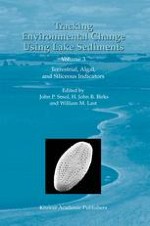2001 | OriginalPaper | Buchkapitel
Pollen
verfasst von : K. D. Bennett, K. J. Willis
Erschienen in: Tracking Environmental Change Using Lake Sediments
Verlag: Springer Netherlands
Enthalten in: Professional Book Archive
Aktivieren Sie unsere intelligente Suche, um passende Fachinhalte oder Patente zu finden.
Wählen Sie Textabschnitte aus um mit Künstlicher Intelligenz passenden Patente zu finden. powered by
Markieren Sie Textabschnitte, um KI-gestützt weitere passende Inhalte zu finden. powered by
Pollen grains are produced and dispersed as part of the plant reproductive process. They are usually spherical or elliptical and in the size range 0.01 mm to 0.1 mm. The outer walls are extremely resistant to chemical and physical attack and are ornamented and perforated in various ways. Pollen grains are found abundantly in a variety of sediment types, from which they can be concentrated and identified, using combinations of shape, size, ornamentation, and perforations. Identification is typically at the level of genus or family, but within some groups may be possible to species level.Analysis of the pollen content of sediments, especially from peats and freshwater lakes, was introduced about a century ago, and has developed into the most widely used and applicable technique for determining past vegetation dynamics through time. Results of pollen analyses have also been used to estimate past climate and human impact on vegetation. Numerical models of pollen dispersal are becoming increasingly sophisticated and are being used, for example, to help determine the relative proportions of woodland and open vegetation in past landscapes, solely from fossil pollen data. Numerical analyses are also helping to interpret fossil pollen by identifying major directions of variation in datasets. Problems exist with taxonomy and taphonomy, but pollen analysis remains a leading technique in past environmental reconstruction.
